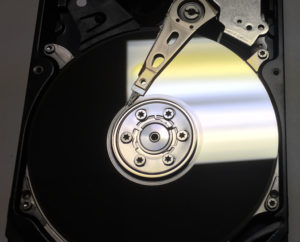
The exposed platters of a traditional hard drive.
Researchers at the University of Sydney have theorized a new architecture that could manage data errors in quantum computers, potentially solving a major roadblock in the technology’s development.
Dominic Williamson and Nouédyn Baspin, researchers at the University’s Nano Institute, introduced the approach in a paper published in the journal Nature Communications.
“Our proposed quantum architecture will require fewer qubits to suppress more errors, liberating more for useful quantum processing,” said Williamson in a statement accompanying the paper.
If you have no idea what “qubits” are — or how quantum computing could impact virtually everything — here’s what you need to know.
Quantum Computing: A Brief Overview
Quantum computers are a theoretical technology that uses the principles of quantum mechanics to perform powerful calculations.
Traditional computers store data in a binary format (as bits representing 0 or 1). Quantum computers use qubits, which support superposition. That means that qubits can represent 0, 1, or a combination of both simultaneously.
Superposition, along with another quantum phenomenon known as entanglement, allows quantum computers to tackle problems that are impossible for even the most advanced classical computers to solve.
Another way to think of it: Traditional computers operate like a light switch that can be either on or off. A quantum computer is like a dimmer switch that can be on, off, or any brightness in between. That allows for much greater flexibility and power — but it also amplifies the potential for data errors.
Quantum Error Correction
When errors occur frequently, computers become less useful — that’s a longstanding issue for every type of data storage technology. But for quantum computers, error correction is a massive undertaking.
“There remain significant barriers to overcome in the development of a universal quantum computer,” Williamson explains. “One of the biggest is the fact [that] we need to use most of the qubits – quantum switches at the heart of the machines – to suppress the errors that emerge as a matter of course within the technology.”
Williamson and Baspin theorize an architecture that allows for quantum error correction across two dimensions. This 3D arrangement allows for a more robust form of error correction, like having invisible threads that hold the data “together.” Fewer qubits are needed for error correction, which drastically improves the efficiency of the system.
By reducing the overhead of error correction, this approach allows for more complex calculations and paves the way for building larger-scale quantum computers that can tackle real-world problems.
Even with Error Correction, Quantum Computing Must Overcome Serious Challenges
Even with improved error correction techniques, there is still an overhead associated with protecting quantum information. Minimizing this overhead is essential for practical applications.
The technology also has other major bottlenecks that will need to be overcome:
- Qubit Coherence: Qubits are notoriously unstable and prone to losing their quantum properties due to interactions with their environment. This decoherence leads to errors and limits the duration for which quantum computations can be performed.
- Scalability: Building larger-scale quantum computers with a sufficient number of qubits remains a major engineering challenge. Current systems have a limited number of qubits, and scaling them up while maintaining control and fidelity is a complex task — which partially explains why the new architecture is theoretical.
- Quantum Algorithms: While quantum computers have the potential to solve certain problems exponentially faster than classical computers, developing efficient algorithms that leverage their unique capabilities is still an ongoing area of research.
- Software and Hardware Limitations: Software and hardware infrastructure will need to be developed to make quantum computers at scale. Cryogenic systems are currently necessary to maintain the extremely low temperatures required by quantum machines, which is extraordinarily resource intensive.
In short, quantum hard drives won’t appear at your local retailer anytime soon — and while quantum computing is rapidly advancing as a field, the first applications of the technology are likely to be limited (as was the case with traditional computers).
Datarecovery.com is a leading provider for ransomware recovery, hard drive repair, RAID recovery, and other data solutions. To learn more about our services or to schedule a free evaluation, submit a case online or call 1-800-237-4200 to speak with an expert.




